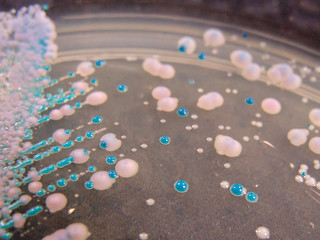What Is Candida?
| Mixed Candida species growing on ChromID Candida 2 Agar - detail (Photo credit: Nathan Reading) |
Candida can be found in different areas of the body. For one you can find it in yeast infections in the vagina, mouth and under nail beds – any place that is warm and dark is a perfect breeding ground for yeast. Candida exists in all of us to some extent, and in small colonies causes no problems. However, when the body is off balance, for example, from taking antibiotics or other medications that disrupt the bacterial balance of the body, an overgrowth of candida can cause problems such as thrush, yeast infections, lowered immune function, and more.
The Diet
Getting rid of a yeast infection can be a vicious cycle. Constant yeast infections in the body can signify a systemic condition. It can affect the health of your immune system. An anti-Candida diet can help to rid the body of the yeast.
The diet is designed to take away the food for the yeast. Thinking of yeast that one would use to make bread rise - warm water helps give the yeast a perfect environment and the sugar activates it.
To get rid of yeast in the body, removing the sugar is the basic idea of the diet. But, there are other places that sugar exists besides simply in the form that we see on the kitchen table. Read the labels. Any food ending in “-ose” is a sugar in disguise and not what you want to eat on any diet designed to rid the body of yeast.
What about natural sugar, such as in fruit? While fruits contain many healthful antioxidants and vitamins, during your anti-candida diet you will want to avoid all sources of sugar - even fruit.
| Sugary Pastry (Photo credit: nathanmac87) |
We have already discussed avoiding sugar in its many forms. Another crucial place where you find sugars is in starchy foods. In the body, these carbohydrates break down into simple sugars. Any sugar is going to keep the Candida infection alive in the body. Avoid refined pastas, potatoes, white bread and anything made with white flour. Basically avoiding all highly processed foods will go a long way towards ridding your body of candida.
Some dairy products can hide sugars. If you like yogurt, be aware that flavored kinds can contain sugar and sabotage your efforts. Go for plain yogurts and those that contain bifidus regularis, acidophilus and other probiotic substances. These are good bacteria that will fight to regain their spot in the intestinal kingdom.
What to Eat
There are plenty of foods left that can tip the scales back in favor of the good bacteria in your body. Eat lots of vegetables, healthy grass-fed meats, omega-3 fatty acids, and garlic.
Drink plenty of water. Water removes toxins from the body. Taking a multivitamin can help rebuild the immune system along with the foods you are choosing to rebuild the bacterial flora. And if you don't eat yogurt, you should take a good daily probiotic supplement
An anti-Candida diet can be followed for as long as you need to, until you are sure that your immune system is back on track. But typically if you are careful and do not eat ANY sugar, 30 days should be about the right amount of time to restore balance to your system.
Supplements That Fight Candida:






No comments:
Post a Comment